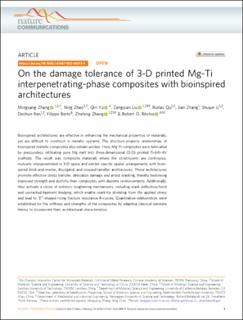| dc.contributor.author | Zhang, Mingyang | |
| dc.contributor.author | Zhao, Ning | |
| dc.contributor.author | Yu, Qin | |
| dc.contributor.author | Liu, Zengqian | |
| dc.contributor.author | Qu, Ruitao | |
| dc.contributor.author | Zhang, Jian | |
| dc.contributor.author | Li, Shujun | |
| dc.contributor.author | Ren, Dechun | |
| dc.contributor.author | Berto, Filippo | |
| dc.contributor.author | Zhang, Zhefeng | |
| dc.contributor.author | Ritchie, Robert O. | |
| dc.date.accessioned | 2023-03-07T09:23:19Z | |
| dc.date.available | 2023-03-07T09:23:19Z | |
| dc.date.created | 2022-09-08T11:50:26Z | |
| dc.date.issued | 2022 | |
| dc.identifier.citation | Nature Communications. 2022, 13 1-13. | en_US |
| dc.identifier.issn | 2041-1723 | |
| dc.identifier.uri | https://hdl.handle.net/11250/3056328 | |
| dc.description.abstract | Bioinspired architectures are effective in enhancing the mechanical properties of materials, yet are difficult to construct in metallic systems. The structure-property relationships of bioinspired metallic composites also remain unclear. Here, Mg-Ti composites were fabricated by pressureless infiltrating pure Mg melt into three-dimensional (3-D) printed Ti-6Al-4V scaffolds. The result was composite materials where the constituents are continuous, mutually interpenetrated in 3-D space and exhibit specific spatial arrangements with bioinspired brick-and-mortar, Bouligand, and crossed-lamellar architectures. These architectures promote effective stress transfer, delocalize damage and arrest cracking, thereby bestowing improved strength and ductility than composites with discrete reinforcements. Additionally, they activate a series of extrinsic toughening mechanisms, including crack deflection/twist and uncracked-ligament bridging, which enable crack-tip shielding from the applied stress and lead to “Γ”-shaped rising fracture resistance R-curves. Quantitative relationships were established for the stiffness and strengths of the composites by adapting classical laminate theory to incorporate their architectural characteristics. | en_US |
| dc.language.iso | eng | en_US |
| dc.publisher | Springer Nature | en_US |
| dc.rights | Navngivelse 4.0 Internasjonal | * |
| dc.rights.uri | http://creativecommons.org/licenses/by/4.0/deed.no | * |
| dc.title | On the damage tolerance of 3-D printed Mg-Ti interpenetrating-phase composites with bioinspired architectures | en_US |
| dc.title.alternative | On the damage tolerance of 3-D printed Mg-Ti interpenetrating-phase composites with bioinspired architectures | en_US |
| dc.type | Peer reviewed | en_US |
| dc.type | Journal article | en_US |
| dc.description.version | publishedVersion | en_US |
| dc.source.pagenumber | 1-13 | en_US |
| dc.source.volume | 13 | en_US |
| dc.source.journal | Nature Communications | en_US |
| dc.identifier.doi | 10.1038/s41467-022-30873-9 | |
| dc.identifier.cristin | 2049878 | |
| cristin.ispublished | true | |
| cristin.fulltext | original | |
| cristin.qualitycode | 2 | |

